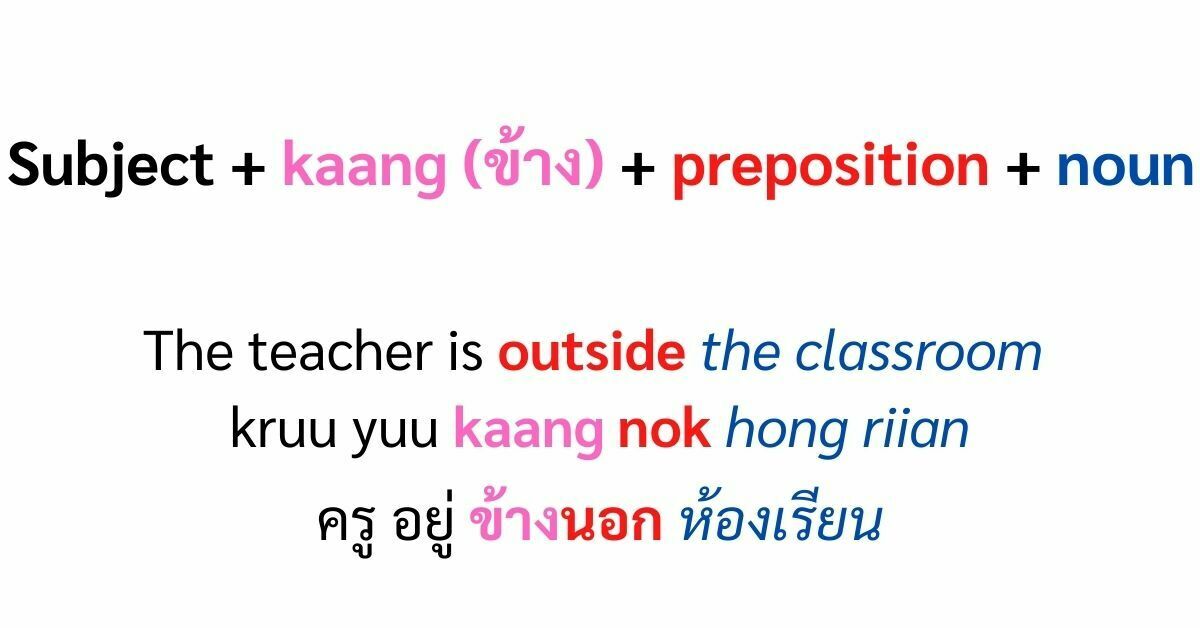Maybe I am a bit stupid, but I didn’t know what a preposition was for the longest time. I knew what a verb was, and how to use adjectives, adverbs, and pronouns, but prepositions were not something I was familiar with. You could imagine my horror when it came time to start learning them in Thai. Now, I look back at myself and wonder why I was ever worried. Whether you know what they are already or are in the same position I was in before, today’s blog post will help you understand and learn some common Thai prepositions.
What Are Prepositions?
First and foremost, prepositions are a group of words that serve a particular purpose, like a verb or determiner. They are generally on the shorter end and play an important grammatical role in a sentence. So what is that role?
Basically, they help to link to words within a sentence. Most often, they are used to represent the relationship an object has with the subject. This can be to do with location, time, or some other kind of connection between the two. I would imagine that we have all been using them but just didn’t know what they are. However, when you look at some examples, it all starts to make sense.
Knowing about their role, we can now look where they are placed in a sentence. In fact, you can get an idea of that just by looking at the word. The ‘pre’ prefix shows that it comes before and the ’position’ part just adds to that. The vast majority of the time, they are placed before a noun or pronoun.
In terms of their usefulness, being able to give proper directions is an obvious bonus, along with learning more about Thai sentence structure. Just generally, it will improve your Thai skills as you can create more fluent sentences in the language much closer to how a local speak it.
Examples Of Prepositions
Using English as an example, there are supposedly over 100 prepositions in total. This does not include prepositions that are part of longer phrases. They are not all used the same amount, with some being more common than others. It really depends on what you are talking about.
Some of the most common prepositions in English are:
in, on, above, behind, of, near, by, down, at, against, across, among, down, between, from, into, under, with, within, to, toward, beneath, beside, before, and along.
I will spare you the whole list of all 100 or so, as I am not so sure of them all anyway. But these examples should give you an idea of what sort of words we are talking about. So then, how do prepositions work in Thai?
Using Prepositions In Thai
Now that we know what prepositions are and how they work in a sentence, we now need to look at how they work in Thai. More specifically, where they are placed in relation to other words. And yes, this is quite necessary to learn as it is used so often in everyday speech.
This is something you learn over time though, so don’t worry too much if most of it goes over your head on the first read-through. I would put them on the same level as Thai classifiers, where it gets easier the more you practice and use them. Learning the concept as a whole is a good starting point, though.
Before learning a few of the more common Thai prepositions, there is another word we need to be familiar with. That word is ‘kaang’ (ข้าง), which means side. Much like many prepositions include the word side in English (e.g. beside, inside, etc.) this word is used in Thai to show location.
The general structure is to use ‘kaang’ before the Thai preposition. This applies mostly when it is placed at the end of the sentence, or when there isn’t a noun following it. However, this doesn’t apply in sentences where the noun follows right after the preposition. As is often the case in Thai, the word ‘kaang’ would be dropped in these situations.
For example:
I should wear a raincoat before going outside
chan kuuan sai suua gan fon gon chan ja ok bpai kaang nok
ฉัน ควร ใส่ เสื้อกันฝน ก่อน ฉัน จะ ออก ไป ข้างนอก
Here, as the preposition outside or ‘kaang nok’ (ข้างนอก) is placed at the end and is not preceding a noun, the word ‘kaang’ is used.
However, this sentence is placed directly before a noun, and so it can be dropped:
The swimming pool is behind the school
sa waai nam yuu daan lang kong roong riian
สระว่ายน้ำ อยู่ ด้านหลัง ของ โรงเรียน
The word for behind – ‘lang’ (หลัง) – is placed before the noun – the school or ‘roon riian’ (โรงเรียน) in Thai – and so ‘kaang’ is not needed.
List Of Common Thai Prepositions
| English | Transliteration | Thai |
| In | nai | ใน |
| Out | nok | นอก |
| Above | nuua | เหนือ |
| On | giow gap, bon | เกี่ยวกับ, บน |
| Behind | kaang lang | ข้างหลัง |
| Near | glai | ใกล้ |
| By | doi | โดย |
| Down | long | ลง |
| Between | raa wang | ระหว่าง |
| From | jaak | จาก |
| Into | kao bpai | เข้าไป |
| Under | pai dtai | ภายใต้ |
| With | duai, gap | ด้วย, กับ |
| Within | pai nai | ภายใน |
| To | tung | ถึง |
| Toward | pai thang | ไปทาง |
| Beneath | pai dtai | ภายใต้ |
| Beside | kaang | ข้างๆ |
| Before | gon | ก่อน |
| Across | kam | ข้าม |
Keep Up Your Learning
For sure, prepositions can be a bit difficult to understand, like with most grammatical things. It only gets more complicated when learning how to use Thai prepositions too. However, keep up your studying, and bit by bit, you should get the hang of using these words to improve your Thai ability. They may not be the shorter words we see in English, but that shouldn’t be something to stop you from achieving your goals.
Want to learn Thai on your phone? The Ling App is one of the best options, with hundreds of lessons, games, and tests that push your ability further. Of course, that includes plenty of Thai prepositions.



















